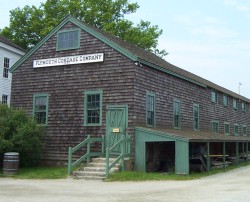 This is a 250-foot segment of the Plymouth Cordage Company’s ropewalk, built by its founder, Bourne Spooner, in 1824. This ropewalk was operated by the firm until 1947, when modernization eliminated its usefulness. The original building, located in Plymouth, Massachusetts, was more than 1,000 feet long and contained three rope-making grounds. It would be impossible, of course, for a sailing vessel to operate without rope, so one can understand the importance of this exhibit to the story of America and the sea.
This is a 250-foot segment of the Plymouth Cordage Company’s ropewalk, built by its founder, Bourne Spooner, in 1824. This ropewalk was operated by the firm until 1947, when modernization eliminated its usefulness. The original building, located in Plymouth, Massachusetts, was more than 1,000 feet long and contained three rope-making grounds. It would be impossible, of course, for a sailing vessel to operate without rope, so one can understand the importance of this exhibit to the story of America and the sea.
The three main steps in the production of rope are illustrated here with the equipment that did the work. Natural fibers are first spun into yarn; many yarns are twisted together to form a strand; and then three strands are twisted together in the opposite direction to form rope. The extreme length of the building was important as the spinning and twisting had to be done in a straight line, and one needed a 1,000-foot-long path to make a 100-fathom (600-foot) rope. The tension of twisting the parts in the opposite direction at each step is what holds rope together.
Early rope was made of either American or Russian hemp, but by the 1830s abaca (manila) was being imported from the Philippines and rapidly became the preferred fiber. Manila is cleaner than hemp, as well as more durable and flexible, and does not have to be tarred, as did hemp, to resist deterioration by heat, rain, and salt water.
Plymouth Cordage made rope for all kinds of vessels, particularly whalers, where strength and endurance were essential. Most of the rigging for the Great Republic, the largest clipper ship ever built, and the manila running rigging for America’s Cup contenders since the first race in 1851, were supplied by the company.
Although the ropewalk is set as if to function, the machinery is not powered. The spinning process, the first step in the process, is portrayed on the second floor of the building. Rope-making (on a much smaller scale) is demonstrated most days by Museum staff.


